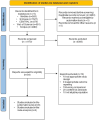Decreased peak atrial longitudinal strain and left atrial contraction strain rate values may predict atrial fibrillation in patients in sinus rhythm at baseline: a systematic review and meta-analysis
- PMID: 40444217
- PMCID: PMC12120665
- DOI: 10.1093/ehjopen/oeaf024
Decreased peak atrial longitudinal strain and left atrial contraction strain rate values may predict atrial fibrillation in patients in sinus rhythm at baseline: a systematic review and meta-analysis
Abstract
Despite the broadening spectrum of heart rhythm-monitoring techniques, the most appropriate modality and duration to detect atrial fibrillation (AF) are not consensual. Two-dimensional speckle tracking for left atrial strain analysis seems feasible to detect atrial cardiomyopathy, which represents a substrate for AF. We aimed to perform a systematic review and meta-analysis on peak atrial longitudinal strain (PALS) and contraction strain rate (pLAct) differences as primary outcomes measured in sinus rhythm (SR) between patients with and without future AF during follow-up (FU). Random-effect model was used. For continuous outcomes, we calculated weighted mean differences (WMD) to compare the two groups We identified eight eligible articles consisting of 1230 patients. Six articles were eligible for quantitative PALS analysis, while three were eligible regarding pLAct. The baseline parameters of the future AF and SR patients were comparable in most of the papers. The PALS value in patients developing future AF was significantly lower compared to patients with no AF (WMD: -5.55% 95% CI -7.06 to -4.03%). Pooled WMD of pLAct between the groups was -0.44 1/s, 95% CI: -0.56 to -0.33 1/s. Baseline PALS and pLAct values of future AF patients were significantly lower than those who remained in SR during FU. PALS and pLAct seem to be sensitive parameters which can be implemented in a predictive model for AF enabling us to find patients who need prolonged heart rhythm-monitoringand it can be also a guidance for oral anticoagulation indication setting.
Keywords: Atrial cardiomyopathy; Atrial fibrillation; Left atrial strain; PALS; Speckle-tracking echocardiography.
© The Author(s) 2025. Published by Oxford University Press on behalf of the European Society of Cardiology.
Figures




References
-
- Sanna T, Diener HC, Passman RS, Di Lazzaro V, Bernstein RA, Morillo CA, Rymer MM, Thijs V, Rogers T, Beckers F, Lindborg K, Brachmann J; CRYSTAL AF Investigators . Cryptogenic stroke and underlying atrial fibrillation. N Engl J Med. 2014;370:2478–2486. - PubMed
-
- Kirchhof P, Benussi S, Kotecha D, Ahlsson A, Atar D, Casadei B, Castella M, Diener HC, Heidbuchel H, Hendriks J, Hindricks G, Manolis AS, Oldgren J, Popescu BA, Schotten U, Van Putte B, Vardas P, Agewall S, Camm J, Baron Esquivias G, Budts W, Carerj S, Casselman F, Coca A, De Caterina R, Deftereos S, Dobrev D, Ferro JM, Filippatos G, Fitzsimons D, Gorenek B, Guenoun M, Hohnloser SH, Kolh P, Lip GY, Manolis A, McMurray J, Ponikowski P, Rosenhek R, Ruschitzka F, Savelieva I, Sharma S, Suwalski P, Tamargo JL, Taylor CJ, Van Gelder IC, Voors AA, Windecker S, Zamorano JL, Zeppenfeld K. 2016 ESC guidelines for the management of atrial fibrillation developed in collaboration with EACTS. Eur J Cardiothorac Surg 2016;50:e1–e88. - PubMed
-
- Benjamin EJ, Muntner P, Alonso A, Bittencourt MS, Callaway CW, Carson AP, Chamberlain AM, Chang AR, Cheng S, Das SR, Delling FN, Djousse L, Elkind MSV, Ferguson JF, Fornage M, Jordan LC, Khan SS, Kissela BM, Knutson KL, Kwan TW, Lackland DT, Lewis TT, Lichtman JH, Longenecker CT, Loop MS, Lutsey PL, Martin SS, Matsushita K, Moran AE, Mussolino ME, O'Flaherty M, Pandey A, Perak AM, Rosamond WD, Roth GA, Sampson UKA, Satou GM, Schroeder EB, Shah SH, Spartano NL, Stokes A, Tirschwell DL, Tsao CW, Turakhia MP, VanWagner LB, Wilkins JT, Wong SS, Virani SS; American Heart Association Council on Epidemiology and Prevention Statistics Committee and Stroke Statistics Subcommittee . Heart disease and stroke statistics-2019 update: a report from the American Heart Association. Circulation 2019;139:e56–e528. - PubMed
-
- Healey JS, Connolly SJ, Gold MR, Israel CW, Van Gelder IC, Capucci A, Lau CP, Fain E, Yang S, Bailleul C, Morillo CA, Carlson M, Themeles E, Kaufman ES, Hohnloser SH; ASSERT Investigators . Subclinical atrial fibrillation and the risk of stroke. N Engl J Med 2012;366:120–129. - PubMed
Publication types
LinkOut - more resources
Full Text Sources
Research Materials

